Rufus G. Russell
Rufus G. Russell (1823-1896) was an architect working from New Haven, Connecticut.
Rufus Gustavus Russell | |
|---|---|
| Born | September 5, 1823 |
| Died | August 3, 1896 |
| Nationality | American |
| Occupation | Architect |
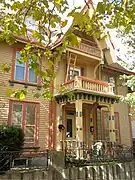
Life and career
Rufus Gustavus Russell was born September 5, 1823, in what is now Prospect, Connecticut.[1] As a young man he moved to New Haven, where he worked for many years for Henry Austin, the city's leading architect.[2] In 1862, Russell left Austin and established his own practice.[3] Russell was an independent practitioner until his death in 1896.
Personal life
Russell was elected to the Board of Aldermen of New Haven on two occasions and was at times also a member of the Common Council. He was active in temperance work and was a member of the Sons of Temperance.[4]
Russell was married and had two children who lived to adulthood.[4] He died August 3, 1896, in New Haven.[4]
Legacy
Russell had an extensive practice. He "designed numerous buildings in New Haven: the Calvary Baptist Church (1871) on Chapel Street, the New Haven Gas Company (1872) on Crown Street, and the Humphrey School (1877) on Humphrey Street. In 1866 he designed the residence of Nicholas Countryman, one of New Haven's leading builders."[2] He would become "one of the best-known architects in New Haven".[2]
He designed the David Lyman II House in 1863, a house which has been regarded as "one of the finest examples of the Gothic Revival style in the greater Middletown area."[2]
At least two buildings designed by Russell have been individually listed on the United States National Register of Historic Places, and others contribute to listed historic districts.
Architectural works
- House for David Lyman II, Middlefield, Connecticut (1863–64, NRHP-listed 1986)[2]
- House for Nicholas Countryman,[lower-alpha 1] New Haven, Connecticut (1866–67)[5]
- Remodeling of the Whitneyville Congregational Church, Hamden, Connecticut (1866, NRHP-listed 1995)[6]
- Howard Avenue Congregational Church, New Haven, Connecticut (1867, demolished)[5]
- First Congregational Church, Wallingford, Connecticut (1868)[7]
- Universalist Church of North Salem (former), North Salem, New York (1869–70)[8]
- Calvary Baptist Church,[lower-alpha 2] New Haven, Connecticut (1871)[9]
- Davenport Congregational Church,[lower-alpha 3] New Haven, Connecticut (1872)[10]
- New Haven Gas Light Company Building, New Haven, Connecticut (1872, demolished)[2]
- Extensions of the New Haven Hospital,[lower-alpha 4] New Haven, Connecticut (1872–73, demolished)[11]
- City Court Building, New Haven, Connecticut (1873, demolished)[1]
- West Divinity Hall, Yale Divinity School, New Haven, Connecticut (1874, demolished)[12]
- Edwards Street School (former), New Haven, Connecticut (1876)[13]
- All Souls Unitarian Church, Washington, District of Columbia (1877, demolished)[14]
- Humphrey Street School (former), New Haven, Connecticut (1877)[5]
- Imperial Granum Building, New Haven, Connecticut (1877, NRHP-listed 1986)[15]
- Institute Library, New Haven, Connecticut (1877)[16]
- Universalist Church of Our Father, Buffalo, New York (1879–80, demolished)[3]
- Garfield Memorial Church (former), Washington, District of Columbia (1881–83)[17]
- Winchester Observatory (former), Yale University, New Haven, Connecticut (1882)[18]
- Warner Hall, New Haven, Connecticut (1892)[10]
Private residences designed by Rufus G. Russell can be found in the Howard Avenue Historic District and the Prospect Hill Historic District of New Haven.
Gallery of architectural works
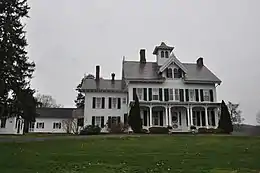 House for David Lyman II, Middlefield, Connecticut, 1863-64.
House for David Lyman II, Middlefield, Connecticut, 1863-64. House for Nicholas Countryman, New Haven, Connecticut, 1866-67.
House for Nicholas Countryman, New Haven, Connecticut, 1866-67.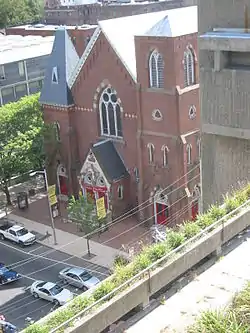 Calvary Baptist Church, New Haven, Connecticut, 1871.
Calvary Baptist Church, New Haven, Connecticut, 1871. Extensions of the New Haven Hospital, New Haven, Connecticut, 1872-73.
Extensions of the New Haven Hospital, New Haven, Connecticut, 1872-73. West Divinity Hall (left), Yale Divinity School, New Haven, Connecticut, 1874.
West Divinity Hall (left), Yale Divinity School, New Haven, Connecticut, 1874.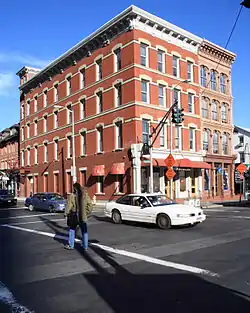 Imperial Granum Building (right), New Haven, Connecticut, 1877.
Imperial Granum Building (right), New Haven, Connecticut, 1877.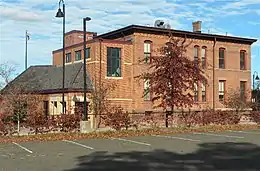 Winchester Observatory (former), Yale University, New Haven, Connecticut, 1882.
Winchester Observatory (former), Yale University, New Haven, Connecticut, 1882. Garfield Memorial Church (former), Washington, District of Columbia, 1881-83.
Garfield Memorial Church (former), Washington, District of Columbia, 1881-83.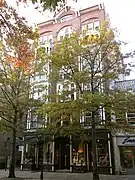 Warner Hall, New Haven, Connecticut, 1892.
Warner Hall, New Haven, Connecticut, 1892.
Notes
- A contributing property to the Howard Avenue Historic District.
- Presently the Yale Repertory Theatre.
- Later the St. Casimir (Polish) R. C. Church, now condominiums.
- Designed in association with Frederick Clarke Withers of New York, New York.
References
- George Dudley Seymour, New Haven (New Haven: George Dudley Seymour, 1942)
- Ruth A. Bedrosian and John Herzan, David Lyman II House NRHP Registration Form (1986)
- "R. G. Russell," in Leading Business Men of New Haven County; and a Historical Review of the Principal Cities (Boston: Mercantile Publishing Company, 1887)
- "Rufus G. Russell," Inland Architect and News Record 28, no. 3 (October 1896): 28-29.
- Elizabeth Mills Brown, New Haven: A Guide to Architecture and Urban Design (New Haven: Yale University Press, 1976)
- Whitneyville Congregational Church NRHP Registration Form (1995)
- Wallingford Center Historic District NRHP Registration Form (1993)
- Frank E. Sanchis, American Architecture: Westchester County, New York (Harrison: Harbor Hill Books, 1977)
- Patrick L. Pinnell, Yale University: An Architectural Tour (New York: Princeton Architectural Press, 1999)
- Colin M. Caplan, A Guide to Historic New Haven, Connecticut (Charleston: History Press, 2007)
- City Yearbook of the City of New Haven...for 1872-73 (New Haven: Tuttle, Morehouse & Taylor, printers, 1873)
- Yale 1883: The Book of the Class Compiled After its Quartercentenary Reunion, ed. George Washington Johnston and Charles Colebrook Sherman (New Haven: Yale College Class of 1883, 1910)
- Orange Street Historic District NRHP Registration Form (1985)
- Jennie W. Scudder, A Century of Unitarianism in the National Capital, 1821-1921 (Boston: Beacon Press, 1922)
- Imperial Granum-Joseph Parker Buildings NRHP Registration Form (1986)
- James F. O'Gorman, Henry Austin: In Every Variety of Architectural Style (Middletown: Wesleyan University Press, 2008)
- Pamela Scott and Antoinette J. Lee, Buildings of the District of Columbia (New York: Oxford University Press, 1993)
- Prospect Hill Historic District NRHP Registration Form (1979)